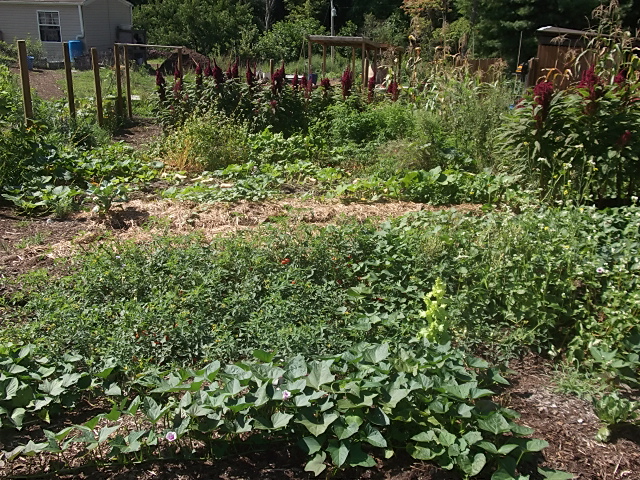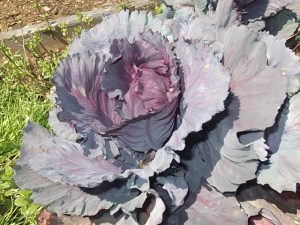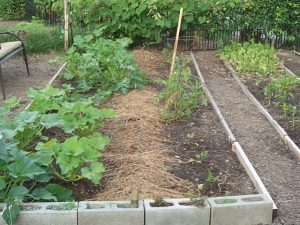I am betting that you’re already familiar with the idea of crop rotation. You may have seen large swathes of farm fields covered with corn one year and soybeans the next. That is crop rotation as its most basic level.
Corn is a nitrogen hog and soybeans are a nitrogen fixer. By planting them back-to-back, you help regulate the nitrogen levels in soil, while producing two important food staples.
More sophisticated monoculture rotations include corn, soybeans, wheat, and a different nitrogen fixer (other legumes). Some rotations even include using the fields to grow grasses and graze horses or cattle for several years before planting again. This practice of incorporating animal grazing is still fairly common in my region.
Though we often associate crop rotation with industrial farming, the idea of rotating fields is an ancient practice. The early rendition is often referred to as “food, feed, fallow” and has been traced back to ancient Rome.
Essentially, in the first year, farmers would grow crops for humans. The second year, they would grow grains and graze animals. The third year, they’d let the field rest so the manure could age. Then the cycle would start again.
Farmers—and more recently gardeners—have been experimenting with crop rotations to varying degrees since those ancient times. In this three-part blog series, I am going to go over some of the main reasons why crop rotation is important and how you can do your crop experimentation at home.
Making your own crop-rotation plan based on what you are growing and how you are growing it will get you much better results than following pre-fab rotational plans made by others who may not have the same challenges as you. That’s because we all have different pest pressure, different pathogen risks, and different ways of amending and tending our gardens.
So, let’s dig into the details of how to create your own crop-rotation plan at home.
There are three primary reasons why people use crop rotation: pest prevention, pathogen control, and nutrient management. Let’s get started by examining pest control.
Pest Control—Rotate Your Planting Times
One of the most common reasons to rotate crops is for pest control. If you grow a large field of pesticide-free cabbage in the same location, year after year, I bet you’d end up with a severe cabbage moth problem.
A single cabbage moth can lay 2,500 eggs in a season. Even if you are diligent at picking off eggs, let’s say you miss some and 10 female cabbage moths make it to maturity and begin to reproduce. Each of them also lays 2,500 eggs, and 10 females (and a few males) make it to reproduction. This goes on for a few seasons.
Even with just a minuscule number of survivors, you jump from 1 moth to 10 moths, from 10 moths to 100, and from 100 moths to 1,000 in just 4 seasons. Instead of picking off 2,500 eggs, you now have to pick off 2,500,000 eggs! In a field full of cabbage, finding all those eggs is impossible—and so the problem grows.
Luckily, it’s easy to break this cycle. Since cabbage moth larva feed pretty exclusively on brassicas or cole crops, take away their food supply and the cabbage moths will have no place to lay their eggs. Without suitable host plants for their eggs, the moths will fly off and look for a better place to lay. Voilà, pest problem solved!
Why Field Crop Rotation Practices Will Not Help the Home Gardener
For the home garden, though, crop rotation for pest management has to be a bit more strategic than just changing planting locations from year to year. Here’s why.
Let’s say you have a 20 x 20 foot garden. Even if you plant cabbage at the top of your garden one year, and the bottom of your garden the next, cabbage moths still only have to fly 20-40 feet to lay their eggs on a host plant. My garden is 100 x 60 feet and cabbage moths fly over the entire area and then go visit my flower patches an acre away. Trust me, 20-40 feet of difference in planting location isn’t going discourage cabbage moths.
How to Use Crop Rotation Strategies for Pest Control in a Small Garden
For crop rotation to be effective in a small garden, you need to think beyond rotating rows and instead think about rotating the timing of your planting to break up the reproductive cycles and prevent infestations.
To do this, you need to know the life cycle of the pest you are trying to control.
As an example, the cabbage moth typically has two generations of offspring each year. The first starts in mid-spring and the second in late summer. If you are planting cabbage in both spring and fall, you are literally offering cabbage moths the perfect conditions to increase their numbers from year to year.
Strategy 1: Shift Your Planting Season
A good rotation strategy for controlling cabbage moths and still getting an annual cabbage crop would be to plant in spring one year and fall the next year. By doing this, you cut off the larva food supply during two reproductive cycles back-to-back. Cabbage moths either get the clue and move on, or they fail to reproduce successfully. Either way, you win!
Strategy 2: Start Early or Late Using Larger Transplants
If you must plant cabbage in both spring and fall, then starting earlier or later can help. Mature plants can withstand more insect damage than smaller plants. By transplanting larger plants into prepared soil before the cabbage moths begin laying, you can increase your yields by giving plants a head start over moths.
The challenge with this strategy is that cabbage doesn’t always transplant well after it gets bigger. Growth may be stunted or plants may suffer shock.
Using paper pots that will quickly decompose in the soil can help limit root damage.
Growing transplants in extremely loose planting medium can also make it easier to relocate plants without causing root damage. Note that loose soil medium often requires more watering and nutrient management than heavier mixes.
Strategy 3: Use Observation and Experience to Create Pest Prevention Rotations That Work
Here’s another example to help you figure out how to use the idea of crop rotation for pest control in your garden.
Our first year here, we planted potatoes in an area that had once been covered with crabgrass. We tilled up the soil, amended with compost, and started planting.
Unfortunately, I barely got any potatoes because we ended up with an infestation of wireworms. Those orange mealy-worm-looking guys love living in the roots of grass. It’s like the wireworm equivalent of a nice little house in the suburbs.
Well, when I swapped their suburban grass roots for potatoes, it was like I took those root eaters to Vegas and told them to have a great time on my tab. They went crazy, decimated my potatoes, and exploded their population in the process. Wireworms gone wild in my potato patch … Yikes!
That experience taught me something, though. Don’t plant potatoes after grasses if you have wireworms! Since corn, sorghum, and wheat are grasses, I don’t plant potatoes after those plants for at least 2 years as a habit now.
Strategy 4: Keep Adapting Your Rotation Plan for New Pests
Good crop rotation for pest management is not just a “set and forget it” kind of activity. It’s something you’ll need to update as new pests make their way into your landscape.
Last year I saw my first blister beetle. Actually, I saw hundreds of them. They were demolishing the leaves of my potato plants. This brand new pest had sailed in and started devouring plants that I’d been growing diligently for over 3 months.
Well, I wasn’t going to have that! So, I got a bowl of water and started knocking them into it.
My chickens love eating all sorts of beetles. I was about to take those pesky pests to my chickens, when some inkling of intuition told me to identify them first. I covered the bowl and hit the computer.
The first site I found started with something like “lethal to livestock.” They call them “blister beetles” because they cause blisters if you squish them by hand. The same substance that causes blisters in humans can kill a chicken with the smallest taste and even take out cattle with large infestations.
More research revealed that pigweed is a host plant for these bugs. I wasn’t growing pigweed, but I was growing Elephant Nose amaranth—pigweed’s city cousin—right next to my potatoes.
I went back to the garden, checked my amaranth plants and discovered even more blister beetles. They were covered with them. Except the blister beetles weren’t eating the amaranth—they were just living there and going across to the neighbor’s for dinner (i.e., my potatoes). I had found their secret hideout!
Well, down came the amaranth, and out went the blister beetles. I had to pick some more off my potato plants since they apparently hadn’t gotten the memo that I’d destroyed their habitat. However, they didn’t return once I removed the amaranth from my garden.
I had been using amaranth as an exotic edible to sell at the farmers’ market and as a trap plant for flea beetles since they like it a lot more than my other leafy greens. However, those blister beetles are such bad news that amaranth is now rotated out (of the garden) for good.
Steps For Making Your Own Pest-Prevention Crop-Rotational Schedule
As you can see, using crop rotation for pest control in a small garden is not just about moving plants to new locations. It is about managing pests by knowing their reproductive cycles and their food and habitat preferences, and using that understanding to plan useful rotations.
I know it can be a bit tricky to figure out at first. Try these tips to help plan your strategy:
- Start by identifying your most persistent pests.
- Study up on how the multiply, what they eat, and where they live.
- Use that knowledge to time your planting to interrupt reproductive cycles, limit the pests’ food supplies, and offer less hospitable habitat. Aim to break up at least one reproductive cycle to keep your populations in check. You may need longer interruptions for serious infestations.
- If your strategies effectively reduce pest populations, then incorporate them into your planting calendar and crop-rotation plan.
- Repeat as necessary!
Other Examples of Pest-Prevention Crop Rotations
Here are a couple of other rotations I have figured out based on our pest pressure that might help you create your own rotations.
1. Squash Bugs
Squash bugs only have one reproductive cycle per year. However, they are so good at hiding and flying large distances that it has proven impossible to control them with short interruptions.
Instead, we only grow plants in the curcurbit family for two years, then we take a year off.
We still hand-pick and kill squash beetles. We also choose varieties like Seminole Pumpkin and a Virginia strain of Waltham Butternut Sqaush that seem less bothered by these pests than other squashes.
During our off year, I arrange to have others grow us squash and cucumbers in exchange for something we are growing. Or I buy from local farmers I trust.
After our year break, we still have a few squash beetles that have managed to stick around or found us again. However, their numbers are low and controlling them is easier! This strategy seems to prevent squash borers, too.
2. Mexican Bean Beetle
I thought I’d struck gold when I first saw these yellow ladybug-looking insects moving in to my garden. Who wouldn’t want thousands of beneficial lady beetles coming to eat your aphids and other pests?
Except, these lady beetles were the one kind that is not beneficial to your garden. These were Mexican Bean Beetles. Within days, they had consumed my bean leaves and desiccated my vines.
I tried to pick them off. Since I had planted the 3 sisters (beans, squash, and corn), I couldn’t find them all and their population exploded (as described for cabbage moths above).
Well, then I noticed that they had left a few plants mostly unscathed. Those were the plants running along my fence, planted on their own—mostly for aesthetic purposes—that I’d been watering regularly because they were closer to my water barrel.
The next year I planted a bunch of beans in a plot by themselves. I neglected them—no watering, no weeding. Those sad little plants still managed to grow and even produce, but they were clearly quite stressed.
When the bean beetles emerged, they went straight for my sad little bean patch. I waited until they had laid their eggs and I saw a few larva crawling on the plants. Then I yanked those plants and burned them!
After that, I planted my real beans in a different location. I treated my new plants like royalty to ensure good health. I still had a few bean beetles show up on my well-cared-for real beans. Since I planted those beans on flat trellises rather than as a companion planting, I picked survivors off with ease.
This strategy worked well because bean beetles do most of their laying in June in my area. This still left me plenty of time to plant and grow beans late in the season.
Since I am planting beans later when our temperatures are warmer, I choose varieties that germinate in warmer temperatures and can take the heat. Cowpeas always germinate in high heat, but there are other varieties that work well, too, like scarlet runner beans.
Final Words on Crop Rotation for Pest Control
This might seem like a lot of information to take in. But I have literally just shared my entire crop rotation plan for controlling pests in my garden.
- I use seasonal cabbage rotations to control cabbage moths.
- I rotated amaranth out of the vegetable garden permanently.
- I take a year off after two years of growing curcurbits.
- I grow a trap plant for Mexican Bean Beetles and plant my real bean crop after the mating season for this troublesome pest has passed.
I have a few more pests that visit my garden, like Harlequin bugs, aphids, and tomato hornworms. Luckily, their populations are so small that hand-picking is sufficient to keep them in check.
You won’t need to use crop-rotation practices for every pest you have, just for those that interfere with your production (or that might be dangerous to livestock, like blister beetles). However, there are two other big reasons why good crop rotation is important—pathogen control and nutrition management. And we’ll get to those in our next two posts.
What kind of insect pests are you dealing with in your garden? Do you already use crop rotation to help manage them? What works? Or has this post sparked some new ideas you might try this year? Please share your challenges, ideas, and successes in the comment area below. I’d love to hear your thoughts!

Tasha Greer is a regular contributor to The Grow Network and has cowritten several e-books with Marjory Wildcraft. The author of “Grow Your Own Spices” (December 2020), she also blogs for MorningChores.com and Mother Earth News. For more tips on homesteading and herb and spice gardening, follow Tasha at Simplestead.com.












COMMENTS(7)
Thank you for giving me some great ideas for combating those pests! I have a huge battle going on with gophers right now and I’m afraid they are winning the battle! I’m so relieved you discovered blister beetles to be detrimental to livestock BEFORE you gave them to your chickens! I would not have known.
Hey Toni – We don’t have gophers were I live now, but I did when I lived in California. Our best protection was our cat George. He never quite managed to eradicate them, but he kept their population in check. In my area we have voles, Our cats now are pretty good at keeping them under control too. However, I have several friends with more severe problems who now garden in raised beds set on concrete to prevent voles from digging. I hope you find a solution to your gopher problem. Thanks for reading!
Tasha, excellent article! My garden is relatively small too – I think all of us are in that situation 🙂
I was just reviewing Justin Rhodes presentation which will air at our upcoming “Home Medicine Summit” in mid-May (lucky me! I get to see all of them, and early too). Anyway Justin divides his garden up into two halves. Each year he keeps the chickens on one half (and let’s them do the tilling, weeding, fertilizing, etc. that they naturally do). He switches up the sides the chickens are on from year to year which interupts insect cycles in a big way.
I was looking around my garden this spring for a place to grow tomatoes… ha, ha, couldn’t find one. Next year I am going to try this. To get more ‘space’ out of a garden plot I liked the idea of the author of “Growing World Record Tomatoes” can’t remember his name right now… but he was using indeterminite tomatoes, only grew one or two plants which he really took care of, and used this massive tower to get a ton of production out of one small spot. Which was then (easier) to move around.
One last idea. I heard about an Amish system of rotation that was focused on not only pest control and nutrition, but also weed control. Here is the rough idea. They would plant in a square dived up into four sections. Each year what was planted would change by section. If I recall correctly the rotation was alfalfa, corn, and potatoes. The alfafa was a nitrogen fixer and soil builder – which they also used some of it for animal feed. The corn came after (as it is a heavy feeder and loves the nitrogen). And finally potatoes were planted. And when the potatoes were dug, as you harvested them, you naturally did weeding and a small bit of hand tilling. Then alfalfa was planted again and the rotation continued.
Great article!
Marjory – These sound like great ideas too. I haven’t tried Justin’s method exactly, but I do let my chickens out in my garden in winter so they do some pest control for me. If I turn over a scoop of soil with a shovel, the chickens come running and then work that area intensively. I use that trick to direct them to beds that had pest problems during the growing season. I also have a mobile coop that I move over my garden rows to let chickens scratch, weed, fertilize, and also till in cover crops for me. I also have lots of pollinator plots near the garden too so that beneficial insects have places to overwinter undisturbed by m chickens.
I am totally with you on the indeterminate tomatoes. They just keep producing, so they are a good use of space as long as you put up a good trellis!
Thanks for sharing these ideas! I’ll have to check out the alfalfa, corn, potato rotation you mentioned.
Looking forward to hearing more about the Home Medicine Summit!
Loved it!!! Thanks for all that information. I deal mainly with edible weeds and perennials, so crop rotation is an area I really need help with. I loved the bean beetle solution. Kill it with fire! Great stuff.
It’s a bit beyond the scope of this post, but you can even use weeds as part of your crop rotation. I use chicory to drop my soil pH if I start edging above 6.8. If my soil is a perfect 6.5 in spring, and I need a cover crop to slot in before I plant my post-frost stuff, dead nettle is my go to weed. For reasons I can’t explain, it really works well to hold soil right at 6.5. I wouldn’t recommend these strategies for people who don’t have a love of using weeds because you inevitably end up with some bonus weeds where you don’t want them. But since I know you are a weed man, I thought you might want to consider it. (Love your weed garden series by the way).
Mexican Bean beetles are awful – they decimated my squash and zucchini our first year gardening. Fortunately, we had already harvested a LOT of both that year. I first noticed them when they were the prickly beetles, then I thought I had wonderful lady bugs. Ugh. We have managed to reduce them in recent years to the point where they are almost not a problem. On the other hand, we have a new pest – little worms are getting into my squash and cucumbers toward the end of the season. I guess we’ll see what happens this year.